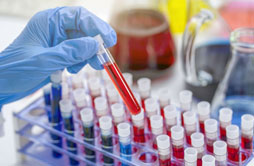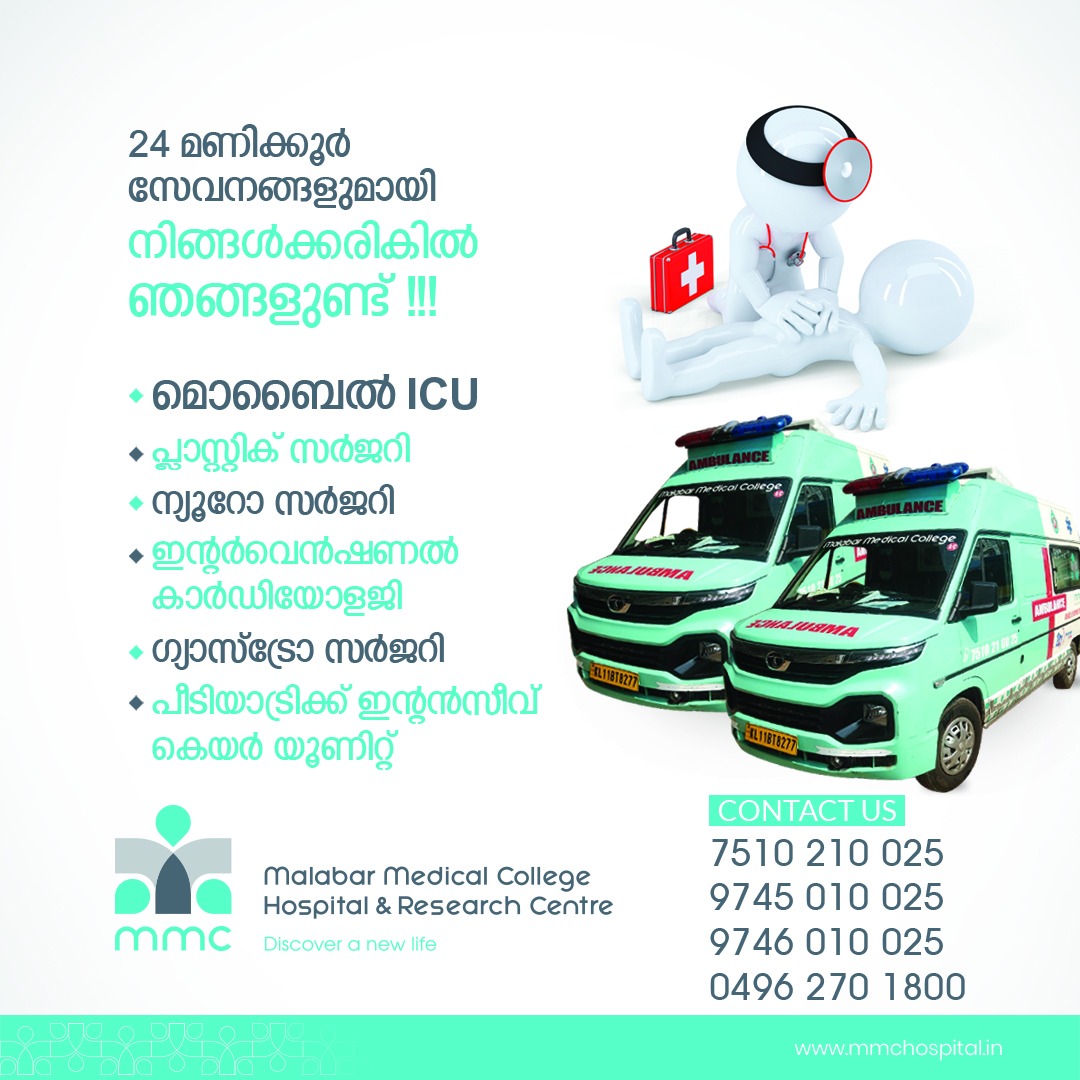Blood Bank

The Malabar medical college blood bank was established in 2009 and since its inception has strived to maintain quality blood banking procedures at affordable rates. Initially the blood bank operated with just a handful of technicians and one doctor and the service was primarily concentrated on the supply of whole blood. Gradually, we advanced in the Use of latest technology and now our blood bank has state of the art component separation facilities and strict quality control procedures. We also have round the clock technicians to enable blood issue without delay.
In addition our blood bank also has a proud group of committed students under the BLOOD DONORS FORUM "RUBRO"- Who strives to provide voluntary non-remunerated blood donation when patients are unable to arrange donors, especially in case of medical emergencies
Whole Blood Contains
- Red blood cells for transport of oxygen to tissues
- White blood cells for defending infection
- Plasma containing proteins and other biomolecules
Compatibility testing is required for transfusion of whole blood
Packaged red blood cells (PRBCs)
PRBCs are prepared from whole blood by removing plasma from collection bag. They may be transfused in treatment of anemia resulting from diseases like kidney failure, gastrointestinal bleeding or blood loss due to trauma or surgery. Donor red blood cells must be compatible with recipients plasma
Platelet concentrate
Platelet concentrate is obtained by separation from collected unit of whole blood and is stored suspended in a small amount of plasma, platelets are essential for prevention of bleeding and normal homeostasis. Platelet transfusion is indicated for treatment in bleeding due to decreased circulating platelet count.
Fresh Frozen Plasma (FFP)
FFP is prepared from whole blood and is stored in -80°C. FFP serves as a source of plasma proteins for patients who are deficient in plasma proteins .FPFIT is given in case of: Bleeding, clotting abnormalities, TTP, HUS, factor deficiencies, DIC etc.
Cryoprecipitate
“Cryo” is the precipitated protein portion that results after thawing FFP. Cryoprecipitated antihemophilic factor (AHF) contains coagulation Factor VIII, Factor XIII, Fibrinogen, WF and fibronectin.
TRANSFUSION Transmitted infections (TTI)
- Advanced 4th generation methodology for HIV detection
- HCV & HBsAg detection by 3rd generation kit
- Malaria -both card tests & thick smear examination
- Syphilis-VDRL/RPR method
Blood grouping & Rh status confirmations
- Blood grouping- both forward and reverse grouping.
- By latest gel card technique
- Rh determination by gel card technique
- Du testing -both gel card &manual method
Screening of irregular antibodies &sub groups
Antibodies in blood other than regularly present anti-A, Anti-B antibodies are called irregular antibodies. These may cause transfusion reactions. Our blood bank has facility to detect these irregular antibodies.
Other investigations
- Direct coomb’s test
- Indirect coomb’s test
- Cross matching-gel card technique
Clinical Nutrition & Dietetics

Diet plays a vital role in the treatment. Patient’s proper diet is the key of good health. Inadequate and improper diet are not only responsible for under nutrition but also contribute to several chronic degeneration diseases such as cardiovascular disease diabetes and cancer.
The clinical nutrition and dietetics department which consist of dietitian got a role in the dietitian making system for patients care. Dietitian not only a cater to the patient’s food requirement but also they are responsible for the planning prescribing and counseling patient’s about their diet according their diseased condition.
OBJECTIVES
- To maintain good nutritional status of all patients.
- To educate patients about how diet plays a major role in the treatment of various disease.
- To modify the daily diet pattern of their requirement during various diseased conditions.
- To correct deficiencies especially in patients with prolonged hospital stay like cancer patients are critical care unit patients.
Diet therapy in the most instances is not a remedy in itself but is a measure which supplements makes the medical or surgical treatment more effective.
ACTIVITIES
The clinical nutrition and dietetics department perform three major activities that are
- In Patient Dietary Service
- Critical Care Service
- Out Patient Service
IN PATIENT DIETARY SERVICE
- All in patients are screened for nutritional risk by qualified dietitian based on metabolic anthropometric and biochemical data and provide nutritional care.
- Individualized nutritional care is provided to all in patient with a dietitian attending to each one of them.
- To patients are offered a wide choice of food items based on the nutritional requirement. all efforts would be made to provide special meals catering to patients in accordance with their condition.
Educational material will be provided nutritional assistance /diet counseling will be given for the following medical conditions.
- Metabolic disorder like diabetes mellitus
- Cancer
- Gastro intestinal disorder
- Kidney disorder
- Women and child health
- Eating disorder and neuro
- Weight management
- Enteral nutrition
CRITICAL CARE SERVICE
The critical care dietitian will assess and provide nutritional input to all patients admitted in critical care units and review these patients on a regular basic on obtain better out come and speedy recovery continuous ryles tube feeding is initiated for critical care patients on Enteral nutrition under supervision of the dietitian.
OUT PATIENT SERVICE
From Monday to Saturday 9am to 5pm
Every individual needs to plan a diet to suit their life style and society health condition to load a healthy life if a diet plan has been made so far please feel free to contact our dietitian at the diet clinic.
dietitian in this clinic not only plan diet specific for your needs but well also educate on healthy eating habits and life style modification information on safe dietary practice will also be provided.
The department of clinical nutrition and dietetics at the hospital provides counseling who either at the referred by the doctors or those who volunteer to referred by the dietitian .the dietitian acquire the history to each of the patient before charting out a diet plan.
Pharmacy

We have a two Pharmacies and one Jan Oushadhi Pharmacy inside MMC Hospital. The main pharmacy is located in the first floor near the Front Office with five convenient counters. You can hand over your prescription to the Pharmacy counter and relax in the chairs provided in front of the pharmacy. Also, there is a Television provided in this area to engage yourself, while we pack your medicines.
Receive your packets of Medicines on Payment, when your token number is called from the counter. With the token facility enabled, the patient or bystanders need not wait in lines before the pharmacy counter. The second Pharmacy is on the ground floor near to causality.
The Pradhan Manthri Jan Oushadhi Pharmacy is located on the third floor in front of the lift door itself, and from here patients can buy generic medicines.
Laboratary
Our hospital laboratory is very well-equipped, modern labs for Clinical Pathology, Haematology, Biochemistry and Microbiology. Samples processed in our medical facility lab include urine, blood, plasma, serum and tissue. Technicians are trained to operate and maintain the instruments; depending on throughput, there could be multiple shifts. This in turn contributes significantly to efficient patient management. Labs are equipped with some of the latest fully computerized state of the art equipments which ensure accuracy and dependability of the investigations done.
Nursing

The Department of Nursing at MMC play a paramount role in providing quality nursing care. Merit is the only criteria for us while selecting our Nursing staff. They are further given an environment where continuous professional improvement is emphasized including patient's safety. Our Nurses care for patients with compassion and respect. Consequently, they are unmatched in academic excellence, clinical expertise and empathy. This makes Nursing Care of MMC truly exceptional.
Through quality nursing service, we give more importance to caring, caring is possible in every single case. We also believe that the nursing doesn't mean just working under a Medical Consultant; rather they are complimentary profession to each other. Nurses not only carry out the order of a doctor, but also make nursing diagnosis and take appropriate nursing measures to prevent further complication to the patient.
Physiotherapy

“Physiotherapists assess, plan and implement rehabilitative programs that improve or restore human motor functions, maximize movement ability, relieve pain syndromes, and treat or prevent physical challenges associated with injuries, diseases and other impairments. They apply a broad range of physical therapies and techniques such as movement, ultrasound, heating, laser and other techniques. They may develop and implement programmes for screening and prevention of common physical ailments and disorders"
1. MUSCULOSKELETAL /ORTHOPEDIC REHABILITATION
Focus on the treatment or rehabilitation of injuries to the orthopedic system which involves muscles, bones, joints, tendon, and ligaments. It also emphasis on rehabilitation of total knee replacement, total hip replacement, ligament reconstruction, lumbar discectomy surgeries, sprain and strains, low back aches, osteoarthritis, Peri-arthritic shoulder, golfer’s elbow, tennis elbow, post fracture rehabilitation protocol for upper limb and lower limb, post traumatic and immobilization stiffness rehabilitation protocols etc.
2. NEURO REHABILITATION
Neurological rehabilitation can often improve function, reduce symptoms, and increase the well being of the patient. It can help to improve or restore the mobility you need to move forward with your life. Some of the condition treated here are stroke, spinal cord injury, Guillain- barre syndrome, transverse myelitis, parkinsonism, traumatic brain injury.
3. SPORTS REHABILITATION
It helps people to alleges to maintain their health and fitness, recover from, prevent injury and reduce pain using exercise, movement and manual based therapeutic interventions. The phases of rehabilitations are: phase 1- control pain and swelling, phase 2 – Begin ROM, and resume cardiovascular training, phase 3- restore ROM, improve strength, endurance and Proprioception, and continue cardiovascular training.
4. GERIATRIC REHABILITATION
Focus on achieving or maintain high level of physical health by considering ailments like arthritis, osteoporosis, Alzheimer’s disease, fall prevention strategies. We tailor our geriatric rehabilitation programs for patients who may have multiple problems – physical, cognitive, and functional needs are all considered. We help families understand the best approach to caring for their loved ones and we empower older patients to live as independently as possible.
5. PEDIATRIC REHABILITATION
Management of children with brain injuries, spinal cord injuries, neuromuscular disorders, and an array of musculoskeletal conditions. Our physios understand how cognitive and physical disabilities affect the growth and development. They incorporate this knowledge to work with patients and their families to develop and direct individualized treatment programs. Main objectives are to restore or improve function and maximize quality of life. In addition, physios work to provide continuity of care as patients transition to adult services.
6. CARDIO-PULMONARY REHABILITATION OR ICU MANAGEMENT
Dealing with optimizing physical function in patients with cardiac disease or recent cardiac surgeries. Cardio pulmonary rehab services can be provided during hospitalization for the event or in an outpatient setting. While the "glue" of cardiac rehabilitation is exercise, programs are evolving to become comprehensive prevention centers where all aspects of preventive cardiology care are delivered. This includes nutritional therapies, weight loss programs, management of lipid abnormalities with diet, blood pressure control, diabetes management, and stress management.
7. OBESITY MANAGEMENT
Aim to incorporate aerobic fitness, strength training, core exercises, balance training, flexibility and stretching into exercise plan. Factoring these into regular routine help to promote fitness for life.
9. PRENATAL & POSTNATAL EXERCISE PROGRAM
Pelvic floor muscle training to prevent urinary incontinence during pregnancy and after delivery. Also core strengthening and stability training to prevent and treat back pain during and following pregnancy.
10. MANUAL THERAPY
Manual therapy is a physical treatment primarily used by physical therapists, to treat musculoskeletal pain and disability; it includes kneading, manipulation of muscles, joint mobilization and manipulations.
11. LOW LEVEL LASER THERAPY
It improves blood circulation and enhances wound healing. Also used for the pain relief and reduction of inflammation. One of the advanced techniques in the physiotherapy field
12. DRY NEEDLING
A skilled intervention that uses a thin mono filament needle to penetrate the skin and stimulate underlying myofascial trigger points, muscular and connective tissues for the management of neuromusculoskeletal pain and movement impairment.
13. HYDROTHERAPY
Use of water in various forms and in various temperatures can produce different effects on different system of the body and are scientifically evidence based. Hydrotherapy is the external or internal use of water in any of its forms (water, ice, steam) for health promotion or treatment of various diseases with various temperatures, pressure, duration, and site. Hydrotherapy was widely used to improve immunity and for the management of pain, chronic obstructive pulmonary diseases, asthma, Parkinson’s Disease, Ankylosing Spondylosis, Rheumatoid Arthritis, Osteoarthritis, fatigue, anxiety, obesity, hypercholesterolemia, hyperthermia, labor, etc.
14. TAPING CONCEPTS
Process of applying tape directly to the skin in order to maintain a stable position of bones and muscles during athletic activity. It is a procedure that uses tape, attached to the skin, to physically keep in place muscles or bones at a certain position. This reduces pain and aids recovery. Taping is usually used to help recover from overuse and other injuries. The general goals of athletic taping are to restrict the motion of an injured joint, compress soft tissues to reduce swelling, support anatomical structures involved in the injury, serve as a splint or secure a splint, secure dressing or bandages, protect the injured joint from re-injury, and protect the injured part while the injured part is in the healing process.
15. MYOFASCIAL RELEASE
Myofascial Release is a safe and very effective hands-on technique that involves applying gentle sustained pressure into the Myofascial connective tissue restrictions to eliminate pain and restore motion. We promote independence through education in proper body mechanics and movement, self treatment instruction, enhancement of strength, improved flexibility, and postural and movement awareness.
Ambulance




